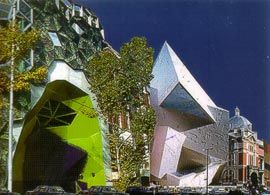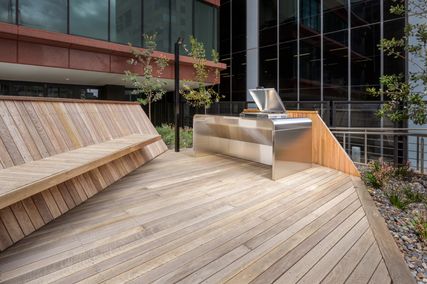
Collage from the back cover of Jencks’s Architecture 2000 and Beyond.
Charles Jencks likes Storey Hall. It gets plenty of praise in the chapter added to the second edition of his polemical book The Architecture of the Jumping Universe. It also features on the back cover of his latest, Architecture 2000 and Beyond: Success in the Art of Predicting. There it is shown collaged with Daniel Libeskind’s Victoria and Albert folded spiral, over the caption: “A fractal urban landscape of the future?”.
Given this attention, it was natural enough that the President of the Victoria Chapter of the RAIA, Ian McDougall, should give Jencks a particularly warm and generous introduction when he delivered a lecture – in Storey Hall no less – in early February.
But perhaps the audience was not feeling so generous. After all, Jencks’s profile as an international star critic and historian derives mostly from his connection with the postmodernism of the late seventies and early eighties. Even those of us who lived through all that are now a little embarrassed by the thought of so much colourful whimsy:
Jencks’s presence was perhaps just too much of a reminder of the discomfort in thinking of our own past enthusiasms.
Could he get over this as he spoke to us?
Has Jencks convincingly transformed himself into a guru of folds and blobs, animate forms and hypersurfaces? Certainly his interest in contemporary architecture was apparent in the lecture – liberally illustrated with the projects of Libeskind, Eisenman, Lynn and Gehry among the internationals, and Lab Architects along with ARM to represent the local scene. The slides illustrated an argument that new paradigms in architecture are emerging which coincide with new modes of computer based design, visualisation, and production. And these appear to correspond with changes that are occurring in science. But the position Jencks argued – that architecture and the arts have a role now of giving public expression to the arcane findings of a range of sciences from astrophysics, fractal mathematics, chaos theory, and a smidgen of biotechnology – is not quite so convincing. Jencks insinuates that these things add up to a single entity, which is shaping our cultural trajectory. But this is a false unity. As Jean-Francois Lyotard argued in his 1984 book The Postmodern Condition, science is now itself a fragmented enterprise, marked by a plurality of local and specific “language games” rather than any singular “grand narrative”.In his introduction to the lecture, Ian McDougall suggested that the issues of emergent complexity that now interest Jencks have replaced the plurality that was a key concern in his earlier work on postmodernism. However, the complexities that Jencks illustrated in his talk were mostly complexities of form, whereas the luralism that he used to address was not only a matter of what things looked like, but also of whose taste cultures they accommodated, of whose interests were served. Is there a social complexity, say, in the new architecture, corresponding to the complexities in its apparent formal and material attributes?
Jencks’s view on this matter, expressed in a brief interview the day after the lecture, is that architecture should be both presentational and representational. Like a good postmodernist, he disavows the opposition between a contemporary complexity and a dated pluralism that cDougall ascribed to him. The propositions promoted by Robert Venturi are, he feels, transformed rather than repudiated in the work of a current generation of notable designers. But, if there are continuities between the old postmodernism and the new complexity, Jencks is also critical of the disjunctions he sees (in Venturi’s work, for example) between the role of the building as a sign and the building as a functional entity. Architecture should not operate as an expressive system alone. Jencks cites a design of his own as an example: the “black hole” terrace in the garden of his Scottish property. Those who occupy the garden are apparently made aware of their own relationship to gravity through the cant and fall of its surfaces, as the concept of the black hole is given visual expression in those surfaces and their material finishes.
But the apparent mismatch between radical forms and less-than-radical institutional programs, in designs such as Gehry’s Bilbao Guggenheim or Lab Architects’ Federation Square in Melbourne, does not faze Jencks. We cannot, he suggests, expect everything to participate fully in a paradigm shift, and even if he is particularly interested in the moments of great revolutionary jumps, most transformations will be more gradual.
Jencks sees Federation Square’s distorted vermiform volumes as a translation of the rectangular prisms of the nearby city office blocks, but he also connects the Federation Square design with the casbah models of urbanism explored by Aldo van Eyck and other Dutch architects in the sixties. There is an engagement in this project between the cultural institution and the concept of the market place to which a commercial city like Melbourne is intimately associated.
Jencks also finds much to praise in at least one local project where architectural form is perhaps less apparently innovative than is the program it houses. The minimalism of DCM’s Melbourne Museum, tempered by historical allusions to the beaux-arts in plan, accommodates an institution which, like other Australian museums, is directly and unflinchingly confronting the pressing issues of cultural difference and conflict.
So, of course, I felt obliged to elicit Jencks’s views of the National Museum of Australia in Canberra. He had a lot to say, nearly all of it expressing his admiration. It is, suggests Jencks, an important building for it raises the fundamental questions for Australians of who they are and where they are going. While these questions cannot be answered, it is a great merit of the building that it faces the puzzles of identity not with esignation but rather with joy.
The two great formal episodes of the building are the Boolean loop (though I cannot accept Jencks’s assertion that it simultaneously gestures entry and acts as a sheltering porte cochere) and the Main Hall.
He finds the latter to be not only a spectacular space, but one full of references which give it interpretative resonance: the Sydney Opera House, Candela, Dr Caligari’s Cabinet, the sculpture of Rachel Whiteread.
The references are not only to high-brow culture (Jencks particularly ridicules the notion that allusions to Libeskind or Le Corbusier are plagiarism) but also to the popular. The pluralism that began to be explored in architecture thirty years ago, and the unconventional forms that are coming out of new ways of conceiving and making architecture, come together in the NMA in a way that Jencks sees as exemplary.
I am left, however, with a nagging doubt.
No matter how fine a building the NMA is, do all our environments have to meld everything so deliriously together? It is perhaps the strength of Storey Hall, for example, that it is not part of a more general “fractal urban landscape”, but that we can enjoy it in the Melbourne streetscape as it is, in all its singularity.















